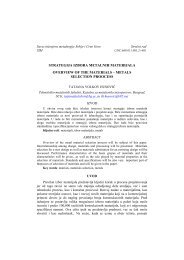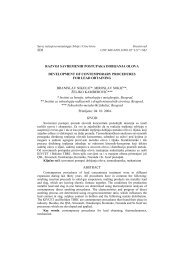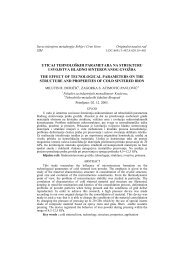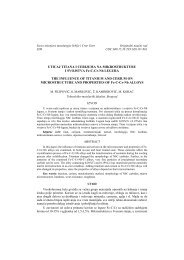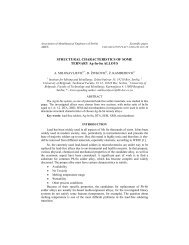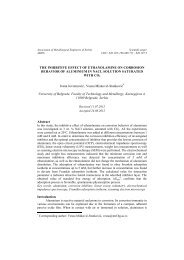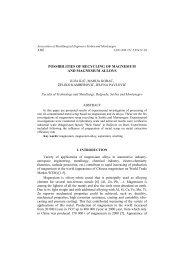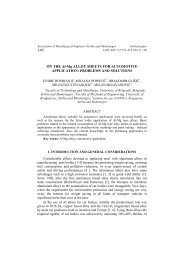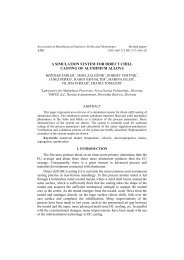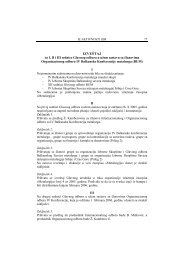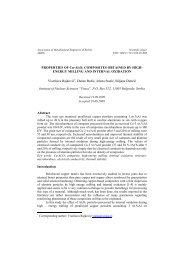EVOLUTION OF PLASTIC STRAINS IN DISSIMILAR WELD OF ...
EVOLUTION OF PLASTIC STRAINS IN DISSIMILAR WELD OF ...
EVOLUTION OF PLASTIC STRAINS IN DISSIMILAR WELD OF ...
You also want an ePaper? Increase the reach of your titles
YUMPU automatically turns print PDFs into web optimized ePapers that Google loves.
Association of Metallurgical Engineers of SerbiaAMESScientific paperUDC: 669.141.1<strong>EVOLUTION</strong> <strong>OF</strong> <strong>PLASTIC</strong> <strong>STRA<strong>IN</strong>S</strong> <strong>IN</strong> <strong>DISSIMILAR</strong> <strong>WELD</strong> <strong>OF</strong>STA<strong>IN</strong>LESS STEEL TO CARBON STEELEslam Ranjbarnodeh * , Mehdi FarajpourGhiamdasht Branch, Islamic Azad University, Tehran, IranReceived 16.08.2011Accepted 15.09.2011AbstractIn the current study, a verified thermo-mechanical model is utilized to investigatethe evolution of stresses and strains in dissimilar TIG welds of low carbon and ferriticstainless steels. The histories of stresses, elastic and plastic strains of the both basemetals are analyzed. The results show that the magnitude of plastic strains increases, asthe yield strength of the base metal decreases while the higher amount of plastic strainsare produced in the similar joint of the stainless steel.Key words: Dissimilar joint; Plastic strain; Strain evolution; Carbon steel; StainlesssteelIntroductionIn arc welding processes residual stresses are produced within the welded metaldue to the high local temperature field and severe temperature gradients [1]. Dissimilarjoints are made between two materials that are significantly different in chemical and/ormechanical senses. When dissimilar metals are joined by a fusion welding process suchas TIG welding operations, alloying between the base metals and filler metal becomes amajor point and as a result the weld metal may show totally different mechanicalproperties as well as distribution of residual stress within the weldment is achieved [2].Till now, there have been a few published studies about residual stresses in similar aswell as dissimilar arc welding operations. For instance; Paradowska et al. [3]investigated the effect of heat input on residual stresses distribution. They found that theheat input affects the value and distribution of residual stresses in the specimen whilethe transverse residual stresses were about half of the maximum value of longitudinalstresses. Teng et al. [4] developed a model to simulate the effects of welding speed,specimen size, mechanical constraint and preheating on residual stresses. Ranjbarnodehet al. [5] studied the effect of heat input on residual stresses in dissimilar joints. Their* Corresponding author: Eslam Ranjbarnodeh, islam_ranjbar@yahoo.com
20 Metall. Mater. Eng. Vol 18 (1) 2012 p. 19-27results showed that the magnitude of stresses at the weld center line increases withincreasing the welding speed.The final state of plastic strains and other variables have been studied in theabove mentioned papers, but analysis of plastic strain history is also important to garnerinsight into the formation mechanism of plastic strains. The analysis also enables betterunderstanding of welding residual stresses. There are few researches investigating thehistory of plastic strains in the welded structures. Fang et al. [6] studied the formationmechanism of longitudinal residual stress and plastic strain in the welding of low carbonsteel. Their results revealed that the tensile plastic strain generated in the coolingprocess cannot counteract the compressive plastic strain generated in the heatingprocess, resulting in the remaining of the compressive plastic strain in the weld afterwelding. Cheng et al. [7] used FEM to simulate the in plane shrinkage strains andwelding distortion in thin wall structures.Regarding the published works on the evolution of plastic deformation inwelding processes, further studies are required to acquire a more completeunderstanding about the welding plastic strains in dissimilar joints. In order to achieve acomprehension of this problem based on a verified model [8] evolution of plastic strainin dissimilar joint of stainless steel to carbon steel was studied in the present work andthe results were compared with the similar joints of stainless steel.Mathematical ModelPrediction of temperature field in welding process is one of the main factors indetermining welding residual stresses and plastic strains. Accordingly, the problem ofheat conduction in the welded structure must be solved. Thus, the following equationcan be used to describe temperature variations inside the parts are being welded:⎛ ∂T⎜kx ⎝ ∂x∂∂⎞⎟ +⎠⎛ ∂T⎜ky ⎝ ∂y∂∂⎞⎟ +⎠∂∂⎛ ∂T⎜kz ⎝ ∂z⎞⎟⎠∂T= ρ C(1)∂twhere T is the temperature, k is the thermal conductivity, C is the specific heat,is the density, t represents welding time, and z, x and y show welding direction,transverse direction and thickness direction, respectively. At the beginning of theprocess (t=0 sec), the entire model was at the ambient temperature. During the weldingprocess, the following boundary conditions were used. Convection-conductionboundary conditions were assumed on surface boundaries except for the region affectedby the moving arc, as presented in Eq. 2:∂T− k = h( T −T a)(2)∂nwhere “n” denotes the normal direction to the surface boundary, T a is the ambienttemperature and h is convection heat transfer coefficient. Convective coefficient wastaken as 15 W/m 2 K for the surfaces in contact with ambient air. The bottom surface ofis in contact with the top surface of the welding fixture. This backing plate, being thick(12mm), acts as a heat sink for the bottom surface. Therefore, the convection coefficientwas estimated as 800 W/m 2 K for this region [9].
Ranjbarnodeh et al. - Evolution of plastic strains in dissimilar weld… 21At the top surface of the model in the region influenced by the moving weldingarc the boundary condition is given as Eq. 3:∂Tk∂y= q() rηVI⎡ 1 ⎛ r ⎞= exp⎢−2⎜ ⎟2πr' ⎢⎣2 ⎝ r'⎠2⎤⎥⎥⎦where “n” stands for the normal direction to the surface boundary, q(r) is surfaceheat flux that was used to simulate the energy transfer from the arc into the surface ofthe workpiece, η is welding process efficiency, V is welding voltage (13V), I is weldingcurrent, T a is the ambient temperature, “r” is the distance from the center of heat sourceand “r’” is the Gaussian distribution parameter which is the radius of area to which 95%of energy is entered [1]. In this work, “r′” was assumed to be 1.5 mm and η was taken as0.6 [10]. The used mesh system is displayed in Fig. 1.(3)Fig. 1. The employed mesh system.At the same time, the mechanical behavior of the weldment should be determinedby equilibrium equation as mentioned in Eq. 4.σ ij , j+ b i= 0(4)where σ ij is the Cauchy stress tensor and b i is the body force (temperature) vectorwhich are calculated from the thermal analysis. Note that the thermo-elastic-plasticbehavior, based on the Von Mises yield criterion and the isotropic strain hardening rule,is considered in the model. In the mechanical part of the simulation, the substantialboundary conditions were u(0,0,0)=0 for the origin of the coordination system and thenormal displacement, u y , equals zero for the bottom surface of the welded platesbecause the top surface of the backing plate acts as a rigid fixture for this surface.Accordingly, the constitutive equation can be written as following [4]:ep thdσ = D dε− C dT(5)
22 Metall. Mater. Eng. Vol 18 (1) 2012 p. 19-27D +ep e p= D D(6)where D ep is the elastic-plastic stiffness matrix, D e is the elastic stiffness matrix,D p is the plastic stiffness matrix, C th denotes the thermal strain vector, dσ is the vector ofstress increment, dε is the vector of strain increment and dT is the temperatureincrement.Experimental dataIt is worth noting that in short samples, 5670 elements and 7130 nodes are usedwhile for the longer samples, 11340 elements and 14105 nodes have been used in theanalysis. In addition, temperature-dependent material properties were employed for bothstainless steel and low carbon steel parts (Tables 1 and 2 and Fig. 2). The specific heatof AISI409 was assumed to be 460 J/kg.K [11]. Furthermore, to take the effect of fluidflow in the weld pool into account, the thermal conductivity was assumed to increaselinearly above the melting point by a factor of about three [12, 13]. The thermalexpansion coefficient of low carbon steel and stainless steel were given to be 11.7×10 -6and 12×10 -6 , respectively. The results of model were validated using X-ray diffractionmethod [8]. TIG welding was applied and the used welding parameters in this study arepresented in Table 3.Table 1. Thermo-physical properties of carbon steel [8].Temperature( 0 C) Thermal Conductivity Temperature C(J/kg.K)(W/m.K)( 0 C)20 51.5 20 425800 29.7 675 8461500 29.7 700 11392000 90 730 1384750 11911000 7791500 4002860 400Table 2. Thermo-physical properties of stainless steel [8].Temperature( 0 C) Thermal Conductivity Temperature( 0 C) C(J/kg.K)(W/m.K)20 25 20 460500 301400 302000 90Table 3. The used TIG welding parameters.Sample Current Length Speed Voltage The base metals(A) (mm) (mm/s) (V)Dissimilar joint 120 450 3.56 13 Stainless steel/Carbon steelSimilar joint 120 450 3.56 13 Stainless steel/ Stainless steel
Ranjbarnodeh et al. - Evolution of plastic strains in dissimilar weld… 23(a)(b)Fig. 2. The mechanical properties of, a) carbon steel, b) stainless steel.Results and discussionFig. 3 shows the temperature cycles at different points of the welded sample. It isshown that the different thermo-physical properties of the base metals resulted indifferent temperature variations. Thermal conductivity of carbon steel is higher than thestainless steel, which in turn, caused higher temperatures at the stainless steel side of theweld [8].Fig. 3. The temperature cycles at different points of the welded sample [8].
24 Metall. Mater. Eng. Vol 18 (1) 2012 p. 19-27Fig.4 shows the transient stresses at two points with the same distance of theweld center line. As it is seen during passing the welding heat source both of the basemetals experience the compressive stresses.However, tensile stresses occur on the cooling stage. The magnitudes of thesestresses are somehow constant during holding in the fixture. After removing the fixturea part of stress will be released and accordingly the amount of stress is decreased. Thestate of stress at the final point shows the welding residual stresses. In general, weldsundergo yielding in the process of cooling after welding; then tensile residual stresses,which are generated by the resistance of the material against contraction by coolingafter welding, remain there [5].Fig. 4. The history of stress at two points of dissimilar weld.The stainless steel with the lower yield strength cannot tolerate welding stressesand yields at the lower stresses. This phenomenon releases stresses and therefore thelower amount of residual stresses is remained in the stainless steel. The history ofplastic strain for the base metals is presented in Fig. 5.Against the plastic strain, the higher values of plastic strains are found for thestainless steel. As mentioned above, it can be due to the lower yield strength of thestainless steel. Another possible reason is the different peak temperatures for the usedbase metal. The lower thermal conductivity of the stainless steel results in the highertemperature that causes the higher amount of plastic strain. To study the effect ofdissimilarity on magnitude of plastic strain, a similar joint of the stainless steel wassimulated and its results were compared with correspondent dissimilar joint, depicted inFig. 6. As it is seen, similar joint shows the higher amounts of plastic strains which maybe attributed to the absence of carbon steel in this joint as a heat absorbent.
Ranjbarnodeh et al. - Evolution of plastic strains in dissimilar weld… 25Fig. 5. The history of plastic strain at two points of dissimilar weld.Fig. 6. The effect of dissimilarity on magnitude of plastic strain.
26 Metall. Mater. Eng. Vol 18 (1) 2012 p. 19-27Fig. 7. The distribution of plastic strain along the x-axis.Therefore, the similar joint will experience the higher temperature and this meansthe higher plastic strain. The distribution of plastic strain along the x-axis is shown inFig. 7. This figure exhibits that the similar joint has the wider plastic strain compared tothe dissimilar joint. It can be due to the lower conductivity of the stainless steel.ConclusionsIn this work, based on a verified model, the evolution of thermo mechanicalbehavior of dissimilar TIG welds of low carbon and ferritic stainless steels was studied.The stress, elastic and plastic strain cycles of different points of the joints of the bothbase metals were analyzed. Also, a similar joint was simulated to compare with thedissimilar joint. The results showed that:1. The base metal with the lower yield strength shows the higher amount of plasticstrain.2. The lower thermal conductivity of the stainless steel causes the higher peaktemperature and plastic strain.3. In the similar joint, the absence of carbon steel, as a heat absorbent, causes thehigher peak temperature and plastic strain.4. The base metal with lower thermal conductivity shows the wider plastic zone.References[1] S. Kou, Welding Metallurgy, John Wiley & Sons, New Jersey, 2003.[2] AWS Welding handbook, Vole 4, Ch 12, 1997.
Ranjbarnodeh et al. - Evolution of plastic strains in dissimilar weld… 27[3] A.M. Paradowska, J.W. H.Price, R. Ibrahim, T.R. Finlayson, Journal ofAchievements in Materials and Manufacturing Engineering, 17(2006) 385-388.[4] T. Teng, C. Lin, Int. J. Press. Vessels Pip. 75(1998) 857–864.[5] E. Ranjbarnodeh , S. Serajzadeh , A.H. Kokabi, A. Fisher, S. Hanke, Int. J. Adv.Manuf. Technol. 55(2011) 649-656.[6] H.Y. Fang, X. Zhang, H. Yang, X. Liu, Q. Shen, Front. Mater. Sci. Chin.3(2009) 75–77[7] W. Cheng, In-Plane shrinkage strains and their effects on welding distortion inthin wall structures. PhD Thesis. The Ohio State University, 2005.[8] E. Ranjbarnodeh, S. Serajzadeh, A.H. Kokabi, A. Fisher. J. Mater. Sci. 46(2010)3225-3232.[9] R.A. Mufti, Mechanical and microstructural investigation of weld based rapidprototyping. PhD Thesis. Ghulam Ishaq Khan Institute of Engineering Sciencesand Technology, Faculty of Mechanical Engineering, 2008.[10] H.R. Saedi, Transient response of plasma arc and weld pool geometry forGTAW process, PhD Thesis. Massachusetts Institute of Technology, 1983.[11] M. Abid, M. Siddique, Int. J. Press. Vessels Pip. l82(2005) 860–870.[12] B. Taljat B. Radhakrishnan B. Zacharia, Mater. Sci. Eng., A. 246(1998) 45–54.[13] A. De, T. DebRoy, J. Appl. Phys. l95(2004) 5230-5239.




